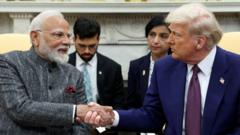The diplomatic rapport between the United States and India is at a historical low following President Donald Trump's imposition of tariffs on Indian goods, specifically targeting the country's importation of Russian oil. Initially described as “good friends” collaborating towards an ambitious trade goal, the recent actions reveal a drastic shift in the dynamics of their relationship.
With total tariffs now totaling 50%, Trump has accused India of financially supporting Russia’s war against Ukraine. This barrage of criticism follows years of mutual progress and cooperation in various sectors. The situation becomes further exacerbated with Trump's remarks labeling India's economy as “dead” and outlining a pathway of additional tariffs if India does not curtail its Russian oil purchases.
While India has maintained a restrained diplomatic front, reacting with claims of the U.S. actions being “unfair and unreasonable,” the escalating situation signifies more than just economic discord. Analysts point out that Trump’s approach has sparked fears in New Delhi about the U.S. commitment to uphold its partnerships. Key issues, including Trump’s equating India with its rival Pakistan, have intensified tensions. Historically, the U.S. has aligned more closely with India's stance against Pakistani mediation, leaving Delhi feeling increasingly vulnerable.
Adding to the complexity, an ongoing U.S. engagement with Pakistan—including preferential tariffs for the country—has incited outrage within India, challenging Modi’s government to navigate the domestic fallout amid rising nationalism. Maintaining trade cohesion while resisting perceived subservience to U.S. demands remains a precarious tightrope walk for the Indian government.
India’s significant reliance on Russian oil, which constitutes over 30% of its total imports, intensifies the conundrum. With energy demands soaring amidst rapid economic growth, leaders maintain that buying discounted Russian oil ensures the national interests of its citizens. Nevertheless, the U.S. regards it as an indirect investment into Russia’s military efforts, placing India in a controversial spotlight.
In response to the tariffs, officials in Delhi assert that necessary measures to protect India’s economic stability will be taken as tensions mount. Critics argue that Trump’s interactions via strong-arm tactics could be a negotiating strategy, lacking an understanding of India's deep-rooted diplomatic standings and history.
Despite current strains, analysts remain cautiously optimistic about the future of the U.S.-India partnership. Recent collaborations in space exploration and technology illustrate that robust ties still exist beneath the surface. The enduring dilemma will ultimately rely on how India decides to address the rift stemming from the ongoing economic grievances while navigating a future interwoven with both U.S. and Russian interests.





















